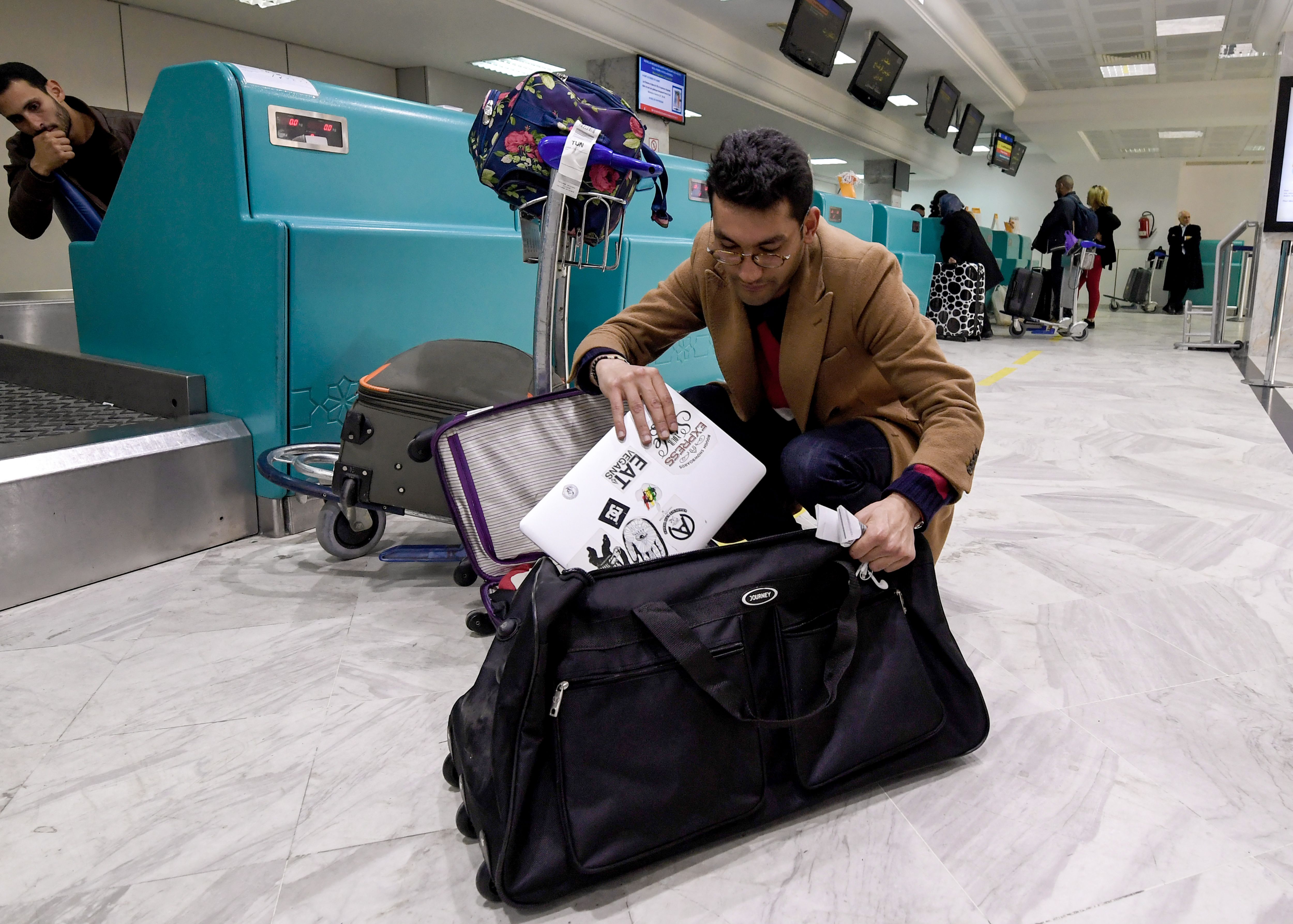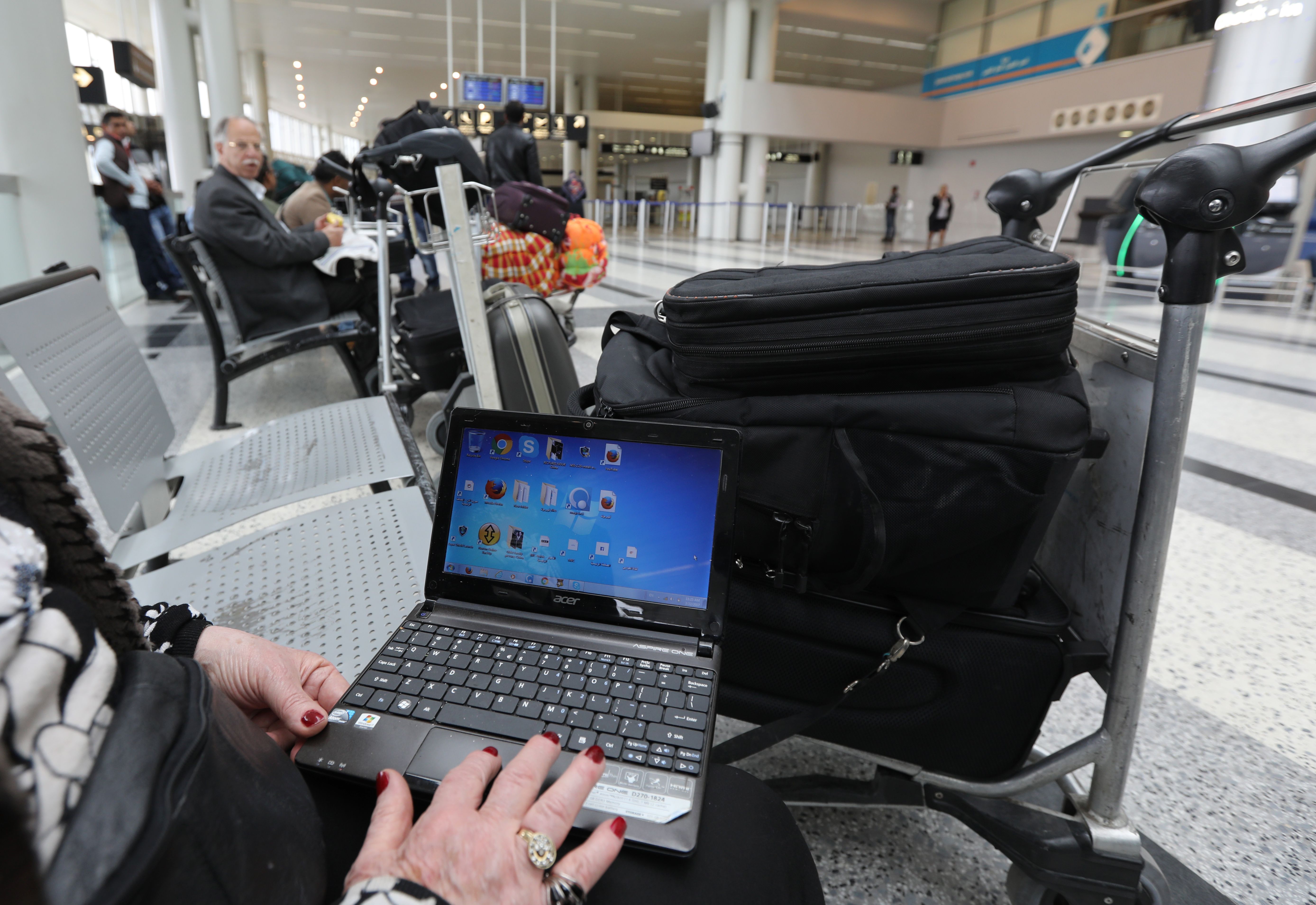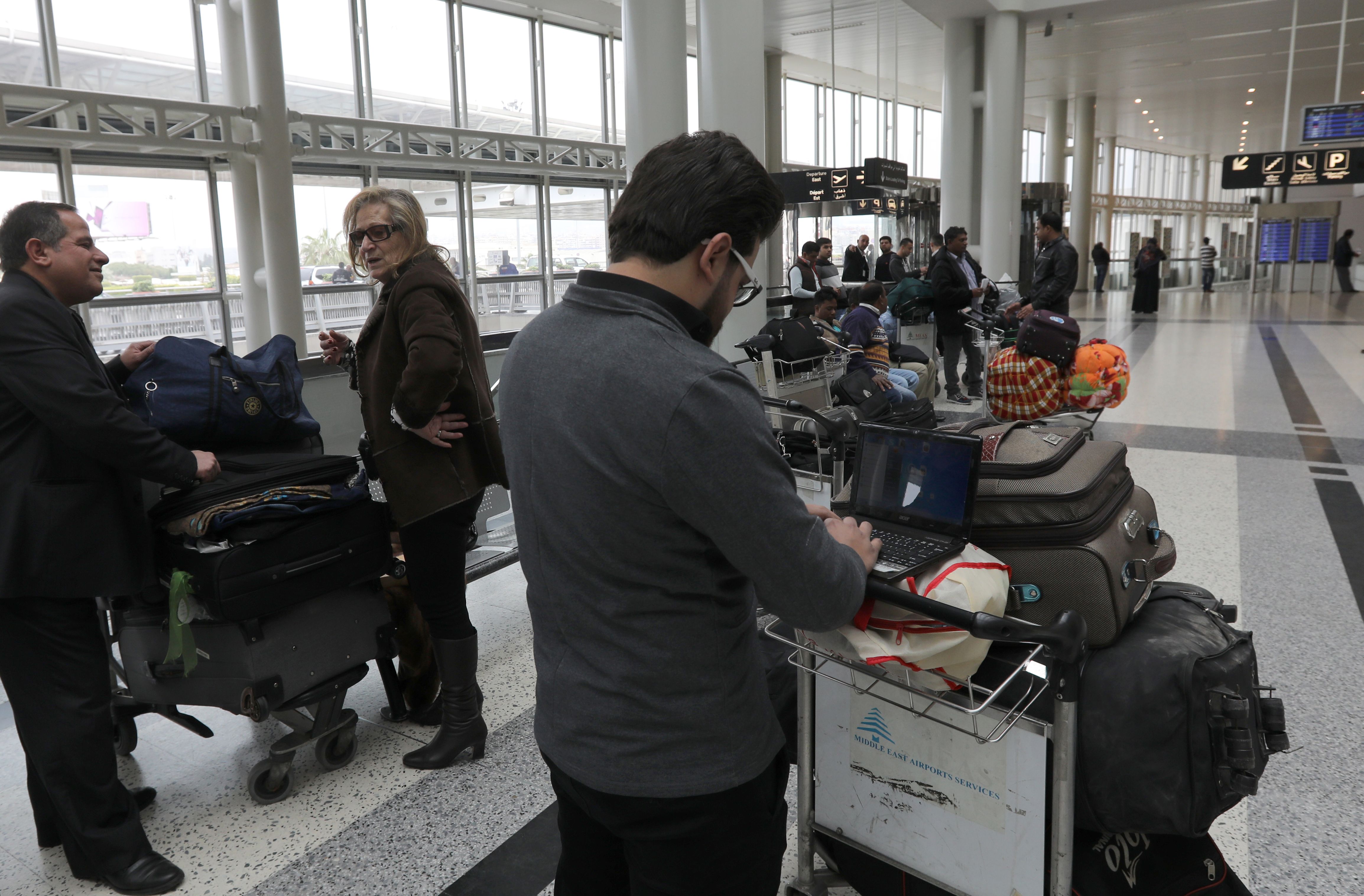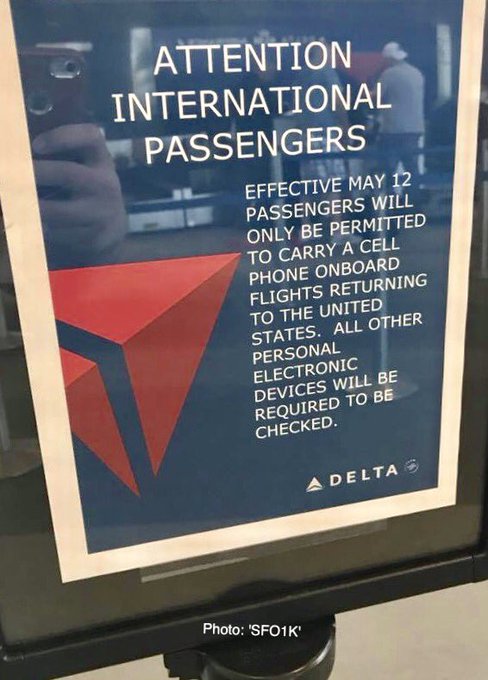
A Libyan traveller packs his laptop in his suitcase before boarding his flight for London at Tunis-Carthage International Airport on March 25, 2017. (Getty)
Intelligence the U.S. gained from a partner about the threat of ISIS and other terrorists using laptops to conceal explosives on planes is at the center of reports that President Donald Trump discussed highly classified information with Russian diplomats during a meeting last week.
The U.S. and its allies have been reacting to recent intelligence that the so-called Islamic State and other terror groups have been working on developing ways to get laptop bombs past airport security and into airplane cabins, leading to a ban on laptops and other devices in carry-on baggage on some flights from the Middle East to the U.S., CNN reported in March.
Current and former U.S. Officials told the Washington Post Trump revealed “code-word information” and “revealed more information to the Russian ambassador than we have shared with our allies,” about the laptop bomb threat, the source told the Post. The revelation “jeopardized a critical source of intelligence on the Islamic State,” the newspaper reports.
According to the Post, Trump revealed the information during the meeting while appearing to boast about his insider knowledge of a threat to the Western world from ISIS involving the potential use of laptops to conceal explosives on airplanes. “I get great intel. I have people brief me on great intel everyday,” Trump told the Russian ambassador, according to the Post. Trump then revealed aspects of the threat that the U.S. has learned through espionage capabilities of a key partner. As president, Trump is allowed to declassify information, the Post reports.
The White House has said the Post’s report is false.
“There is nothing the president takes more seriously than the security of the American people. The story that came out tonight as reported is false,” National Security Adviser McMaster told reporters outside the White House. “The president and the foreign minister reviewed a range of common threats to our two countries, including threats to civil aviation. At no time, at no time, were intelligence sources or methods discussed. And the president did not disclose any military operations that were not already publicly known.”
McMaster continued, “Two other senior officials who were present, including the Secretary of State, remember the meeting the same way and have said so. Their on-the-record accounts should outweigh anonymous sources. And I was in the room, it didn’t happen.”
Here’s what you need to know about the laptop bomb threat:
1. ISIS & Other Terrorist Groups Obtained Airport Security Equipment to Test Their New Methods, CNN Reports
ISIS and other terror groups have learned new ways to conceal explosives in laptops and other explosive devices to evade airport security screening methods, CNN and other media outlets reported in March. According to the CNN report, ISIS obtained “sophisticated airport security equipment” to test how effective its concealment methods were. FBI testing has determined that some of the new innovations are capable of evading some commonly used airport screening methods, CNN reported.
The Department of Homeland Security issued a statement about the reports about the laptop threat:
As a matter of policy, we do not publicly discuss specific intelligence information. However, evaluated intelligence indicates that terrorist groups continue to target commercial aviation, to include smuggling explosive devices in electronics. The U.S. government continually re-assesses existing intelligence and collects new intelligence. This allows DHS and TSA to constantly evaluate our aviation security processes and policies and make enhancements when they are deemed necessary to keep passengers safe. As always, all air travelers are subject to a robust security system that employs multiple layers of security, both seen and unseen.
According to the CNN report, the threat goes beyond hiding explosives in battery compartments. Officials told CNN that ISIS and others have “become sophisticated enough to hide the explosives while ensuring a laptop would function long enough to get past screeners. Though advanced in design, FBI testing found that the laptops could be modified using common household tools.”
The tests by the FBI revealed it “can be done,” ABC News reports.
Sources told CNN the intelligence obtained about the laptop bombs is “specific, credible and reliable,” and one officials called it “hair-raising.”
According to NBC News, Al-Qaeda, through its top bomb-maker, Ibrahim al-Asiri, could be sharing its methods with ISIS to help the terror group develop smaller explosives that could be smuggled onto an airplane and detonated. Al-Asiri is believed to have made the underwear bomb that attempted to take out a Detroit-bound plane in 2009 and two bombs found in U.S.-bound cargo planes that never detonated.
John Pistole, then the head of the TSA, told NBC in 2013, “There is intel that he has unfortunately trained others.”
According to NBC, al-Asiri is believed to have helped train bomb-makers in the Syria-based Khorasan Group. There is believed to be continued cooperation between Al-Qaeda militants in Yemen and ISIS terrorists in Syria.
“We had the shoe bomber, the underwear bomber, the printer cartridge attempt — now this is the next level,” retired FBI agent Manny Gomez told CBS New York. “We need to be more proactive — be several steps ahead of them and go to the next level of technology.”
2. The U.S. Intel Came Through Foreign Espionage, a Raid on al-Qaeda in Yemen & After Explosives Were Used on 2 Flights in Africa

Kuwaiti social media activist Thamer al-Dakheel Bourashed puts his laptop inside his suitcase at Kuwait International Airport in Kuwait City before boarding a flight to the United States on March 23, 2017. (Getty)
U.S. officials told CNN that the intelligence about the potential laptop bombs came through the collection of intercepted materials and “human intelligence.” According to the Washington Post report on President Trump’s meeting with the Russians, some of that intelligence was provided to the U.S. through a foreign partner, which obtained it through espionage efforts.
The Daily Beast reported that information about the bomb threat was obtained during a U.S.-led raid on a terrorist stronghold in Yemen earlier this year. Navy SEAL William “Ryan” Owens was killed during the January 28 raid on an Al-Qaeda affiliate.
According to CNN, intelligence officials received a “wake-up call” in February 2016 when a terrorist from the Al-Qaeda-affiliated al-Shabaab group detonated a laptop bomb on a flight from Mogadishu, Somalia, to Djibouti. The explosives were hidden in a laptop in which the DVD drive was removed, CNN reported.
“Airport workers helped smuggle the bomb on the plane after it passed through an X-ray machine. In that case, the bomber was blown out of the airplane but the aircraft was able to make an emergency landing. However, experts have said the bomb would have been more devastating had the plane reached cruising altitude,” CNN reported.
Thomas Joscelyn, senior fellow at the Foundation for Defense of Democracies (FDD) and senior editor of FDD’s Long War Journal, wrote in Politico that the Somalia incident may have been a test run by terrorists:
Some U.S. officials suspect that Al Qaeda’s elite bomb-makers wanted to test one of their newest inventions, a lightweight explosive disguised as a laptop that is difficult to detect with normal security procedures. At the very least, Shabaab’s attack demonstrated that Al Qaeda has gotten closer to deploying a laptop-sized explosive that can blow a hole in jetliners. While no one other than the terrorist who detonated the bomb was killed, the plane was left with a gaping hole in its side.
According to Joscelyn, ISIS has also showed it has the capability to take down an airliner, if its claims of responsibility for the bombing of a Russia-bound airliner in Egypt in 2015:
Meanwhile, ISIS has also proven it is capable of downing an airliner. Thus far, ISIS leader Abu Bakr al-Baghdadi’s men have used low-tech means. In October 2015, the so-called caliphate’s Sinai province claimed the bombing of a Russian airliner. If the group’s propaganda is accurate, then a Schweppes Gold soft drink can filled with explosives and equipped with a detonator led to the deaths of all 224 people on board. This beverage bomb was a far cry from the sleek explosives Al Qaeda’s bomb-makers have been experimenting with, but it was effective nonetheless. All it required was proper placement next to a fuel line or some other sensitive point in the airliner’s infrastructure. ISIS could have more sophisticated bomb designs in the pipeline as well.
U.S. Representative Eric Swalwell, a Democrat from California, warned of a “new aviation threat” in an interview with ABC News.
“We know that our adversaries, terrorist groups in the United States and outside the United States, seek to bring down a U.S.-bound airliner. That’s one of their highest value targets. And we’re doing everything we can right now to prevent that from happening,” Swalwell said in March.
“Terrorist groups continue to target commercial aviation and are aggressive in pursuing innovative methods to undertake their attacks to include smuggling explosive devices in consumer objects,” said White House Press Secretary Sean Spicer in March.
3. The U.S. Banned Electronics, Including Laptops, From Cabins on Flights From 10 Middle Eastern Airports in March

A Syrian woman travelling to the United States through Amman opens her laptop before checking in at Beirut international airport on March 22,2017. (Getty)
On March 21, 2017, U.S. officials announced that passengers from 10 Middle Eastern countries would be barred from taking electronic devices bigger than a cell phone, including laptops, onto direct flights to the United States, the New York Times reported. British authorities followed with a similar ban involving fewer countries. The ban included some flights from Egypt, Jordan, Saudi Arabia, Turkey, Kuwait, Morocco, Qatar and the United Arab Emirates.
“It was based on intelligence reports that are fairly recent,” U.S. Representative Peter King, a Republican from New York who is on the House Intelligence and Homeland Security committees, told the New York Times. “Intelligence of something possibly planned.”
The ban includes laptop computers, tablets, cameras, travel printers and games bigger than a phone. Flight crews are exempt from the ban. The devices will be allowed to be packed in checked luggage. About 50 flights a day are affected by the new rules, the Times reports.
The ban has resulted in a loss of profits for some airlines, Forbes reports. Dubai-based Emirates Airlines saw an 82 percent dip in year-over-year profits, according to the report.
“The New Year ushered in a new president in the United States, and a new administration which in its first three months issued a raft of new measures relating to entry requirements, enhanced security vetting procedures, and restrictions on personal electronic devices in aircraft cabins,” His Highness Sheikh Ahmed bin Saeed Al Maktoum, chief executive of Emirates Airline and Group, told NBC News. “These all directly impacted Emirates’ operations into the US. We remain optimistic for the future of our industry, although we expect the year ahead to remain challenging with hyper competition squeezing airline yields, and volatility in many markets impacting travel flows and demand.”
4. U.S. & European Officials Are Discussing Expanding the Ban to More Flights

A Syrian passenger travelling to the United States through Amman types on his laptop before entering Beirut international airport’s departure lounge on March 22,2017. (Getty)
Along with the device ban, the U.S. has increased security, including through the use of bomb-sniffing dogs and explosive-trace detection, officials told CNN. Robert Liscouski, a former Homeland Security official turned aviation security expert, told CNN the ban was likely limited to Middle Eastern countries based on the capability and locations of terror groups. Liscouski said U.S., European and other airports have better protections in place and a “better policy regime” setting standards to ensure compliance.
“We don’t have the same level of confidence in other areas of the world because we don’t have the government bodies and stature to assure compliance,” Liscouski told CNN.
But recent reports indicate that U.S. and European officials are considering expanding the ban, possibly to all flights from Europe to the U.S. A photo of a sign from Delta earlier this month notified passengers the device ban would begin May 12. But the airline and Homeland Security officials later said the sign was posted in error:
European Union and American transportation officials are set to meet Wednesday, May 17, in Brussels to discuss a potential expansion of the device ban, ABC News reports. European Commission spokesperson Margaritis Schinas told ABC the meeting is “to jointly assess any new threats and work toward a common approach to address them.”
An expanded ban could affect flights that carry about 65 million people a year on 400 daily flights, according to ABC News.
“We are continually evaluating threats and if a determination is made that a change to our layers of seen and unseen aviation security measures should be made, as we have done in the past, we will work closely with our private sector and public sector partners to ultimately do what is best for the safety of the travelling public,” U.S. Homeland Security told The Guardian in a statement.
Some have said the new plan would cause chaos.
“I think it’s going to be extremely chaotic,” Rich Roth, executive director of CTI Consulting, an aviation security firm, told Bloomberg. “I think they went a little bit overboard in their risk assessment. My opinion is [DHS] may pull the trigger and make it happen but it won’t last for more than a week” because of “blowback.”
Business travelers have said it is important they have their laptops available to them.
“It’s really important for the business traveler to have access to their laptop when they’re traveling to the United States,” Patricia Rojas-Ungár of the U.S. Travel Association told NPR. “Because they’re doing business, but also because there’s some sensitive data on their computers and they want to be able to have their computers close.”
The United Nations has called for a global solution to the laptop issue, Reuters reports.
“The International Civil Aviation Organization (ICAO) met on Tuesday to debate the issue after the Un ited Arab Emirates, Egypt and other countries complained their airlines had been un duly penalized by the decision to relegate laptop s to the cargo hold on some flights due to security concerns, three sources familiar with the matter said,” according to the Reuters report.
5. Pilots Warn the Carry-on Ban Could Lead to Catastrophe Itself, Through a Fire or Other Issues
Pilots are warning that the ban on laptops and similar electronic devices in the cabin could stop the risk of laptop bombs, but create a new “catastrophic” danger: fires in the the cargo hold.
“Given the risk of fire from these devices when they are damaged or they short circuit, an incident in the cabin would be spotted earlier and this would enable the crew to react quickly before any fire becomes uncontainable,” Steve Landells, flight safety specialist for the British Airline Pilots’ Association said in a statement. “If these devices are kept in the hold, the risk is that if a fire occurs the results can be catastrophic; indeed, there have been two crashes where lithium batteries have been cited in the accident reports.
“We don’t doubt the security threats that have led to consideration of extending the ban on devices but we urge the authorities to carefully assess the additional fire risk from storing more PEDs in the hold to ensure we’re not solving one problem by creating a worse one,” Landells said.
According to the pilots’ association, lithium battery fires can spread quickly if not caught early, so International Civil Aviation Organization advice is for the devices to be kept in the cabin so any potential fires can be spotted and extinguish before they enter the “thermal runaway” state where they are almost impossible to put out.
“We have had numerous incidents of devices with lithium batteries suddenly bursting into flames,” pilot Laurie Price told The Independent. “If that is in the aircraft cabin, it can be dealt with. If in the aircraft hold, the fire-suppression systems are unlikely to be able to contain it and there is a lot of material to exacerbate such fires, including other baggage, the aircraft structure, fuel and systems in an area which is inaccessible in flight. The consequences could be catastrophic.”




